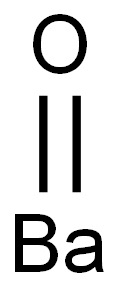Barium oxide , 90% , 1304-28-5
Synonym(s):
Baria;Barium monoxide
CAS NO.:1304-28-5
Empirical Formula: BaO
Molecular Weight: 153.33
MDL number: MFCD00003453
EINECS: 215-127-9
PRODUCT Properties
| Melting point: | 1920 °C |
||||||||||||||
| Boiling point: | 2000 °C |
||||||||||||||
| Density | 5.72 g/mL at 25 °C(lit.) |
||||||||||||||
| refractive index | 1.98 |
||||||||||||||
| solubility | soluble in dilute acid solutions, ethanol; insoluble in
acetone |
||||||||||||||
| form | Powder |
||||||||||||||
| Specific Gravity | 5.72 |
||||||||||||||
| color | Light yellow-greenish to grayish |
||||||||||||||
| Water Solubility | Sparingly soluble in water. Soluble in ethanol, dilute mineral acids and alkali. |
||||||||||||||
| Sensitive | Moisture Sensitive |
||||||||||||||
| Crystal Structure | NaCl type |
||||||||||||||
| crystal system | Cube |
||||||||||||||
| Merck | 14,986 |
||||||||||||||
| Space group | Fm3m |
||||||||||||||
| Lattice constant |
|
||||||||||||||
| Exposure limits | ACGIH: TWA 0.5 mg/m3 NIOSH: IDLH 50 mg/m3; TWA 0.5 mg/m3 |
||||||||||||||
| Stability: | Stable. Incompatible with strong acids, water. Protect from moisture. |
||||||||||||||
| CAS DataBase Reference | 1304-28-5(CAS DataBase Reference) |
||||||||||||||
| EPA Substance Registry System | Barium oxide (1304-28-5) |
Description and Uses
Barium oxide is a white to yellowish-white,odorless powder. Molecular weight=153.34; Freezing/Melting point=1923℃. Hazard Identification (based onNFPA-704 M Rating System): Health 3, Flammability 0,Reactivity 2 . Reacts violently with water.
Barium oxide is used as a coating for “hot cathodes”
in a variety of electronic devices such as TV’s and lamps.
It replaced lead oxide in the production of certain kinds
of glass. While lead oxide raised the refractive index of
the glass, it also raised the dispersion, i.e refraction of
various colors of light resulting in distortion of images
which barium oxide does not alter. Barium oxide also
has use as an ethoxylation catalyst in the reaction of ethylene oxide and alcohols which takes place between
150 and 200°C.
The thermionic emission from thin evaporated films
of barium oxide has been studied extensively. Thin
barium oxide films have a good emission following
evaporation. The emission improves a little during
heat treatment, and is then similar to that from a sprayed
cathode coating of barium oxide.
Safety
| Symbol(GHS) |   GHS05,GHS06 |
| Signal word | Danger |
| Hazard statements | H301-H314-H332 |
| Precautionary statements | P260-P280-P301+P310+P330-P301+P330+P331-P303+P361+P353-P305+P351+P338+P310 |
| Hazard Codes | T |
| Risk Statements | 20-25-34 |
| Safety Statements | 26-36/37/39-45 |
| RIDADR | UN 1884 6.1/PG 3 |
| WGK Germany | 1 |
| RTECS | CQ9800000 |
| F | 3-9-34 |
| TSCA | Yes |
| HazardClass | 6.1 |
| PackingGroup | III |
| HS Code | 28164000 |
| Toxicity | mouse,LD50,intraperitoneal,146mg/kg (146mg/kg),Current Toxicology. Vol. 1, Pg. 39, 1993. |



